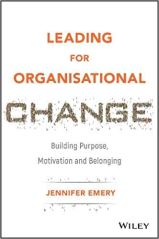
Purpose over Process: How Your Gantt Chart Causes Damage During Periods of Change
Change is coming, everyone in your organisation can feel it and there’s a general undercurrent of unease. We are not creatures who like uncertainty. We’re programmed such that our brains feel better when we can see patterns and predict the future. We like to sense-make.
So, what do many leaders do? They look to rules, plans and processes in the hope of finding—and giving—a sense of comfort. Settling on a plan, writing down a neat list of bullet points, drawing out a Gantt chart, with milestones – it all helps to reduce our perception of risk, and make us feel safer and happier. Countless books on ‘the ultimate change process’ also peddle this world view. If you have a step by step plan, everything will work itself out, right? Wrong.
The false security of process
Processes and plans are false friends in times of uncertainty, first of all because their working depends on context, and as soon as circumstances shift – which is almost constantly during periods of change – aspects of any process or plan process will founder.
Worse, an undue focus by leaders on processes and plans can hurt organisations by limiting them and by failing to unleash the full potential of the individuals within them. It also overlooks entirely the fact that there’s real value to be actively created during periods of change.
To unlock all of the potential in your people and – by extension – in your organisation, and to benefit from the value that can be created by change, leaders should worry less about the details of any process and focus instead on three things – on creating and maintaining absolute clarity of purpose, and then on conveying that through exemplary leadership and great storytelling.
Putting purpose into practice
First off, let’s be clear about what we mean by ‘purpose’. It’s a popular buzzword in the business world and self-help books alike, and spans an array of ideas from a particular perspective on the social purpose of organisations, through to theories around individual motivation at a neurological level. It is both the ‘why’ of an organisation’s existence and the golden thread that connects the individual motivation of every person in an organisation to that ‘why’.
To understand how purpose can help you manage change better, think of it as your organisation’s guiding light. It’s about what your organisation does and why your team—with their unique skills and backgrounds—are joined together to help each other move towards a common goal. A clear sense of purpose confers that sense of safety that we otherwise seek in process, and also brings a huge variety of additional potential advantages which means it leaves process for dust.
In a nutshell, purpose:
- Helps to build a sense of belonging, identity, and common understanding
- Confers confidence and reduces uncertainty
- Means that you can be evolutionary and agile and respond quickly when things change because you’re not dependent on process, and can delegate decision making and trust people
- Energises people, build resilience, creates momentum to do more, incites discretionary effort
- Creates simplicity at a time which is often mired in complexity – you don’t need more processes, more rules, more ad hoc scattergun communications, etc if you have this clear central purpose running through everything
Purpose from top down
Leaders have a critical role to play in shaping and articulating purpose, in communicating it and in helping every individual in the organisation is connect to it personally. A huge part of this is role-modelling. Demonstrably trusting people, relinquishing control, being willing to loosen rules and processes and allow people to be guided by purpose, be vulnerable and evolutionary and willing to check tack now and then.
Another key role of leaders in driving a purpose-led approach lies in storytelling. It’s about telling the organisation’s true story with passion and conviction, time and time again – which is of course a very different matter from just repeating a strapline or vision ad nauseoum. It’s also about asking people for their own stories, listening, helping them to sense make, and weaving it all together into one glorious tapestry of human ideas and endeavour.
Read more about Jen’s experiences in leading people, culture and change during the UK’s largest legal merger.






